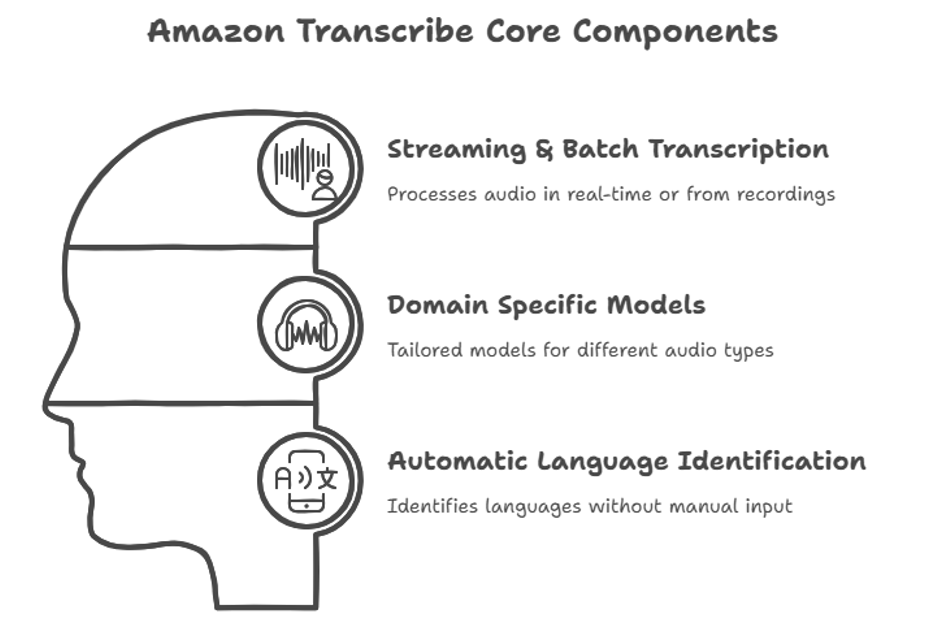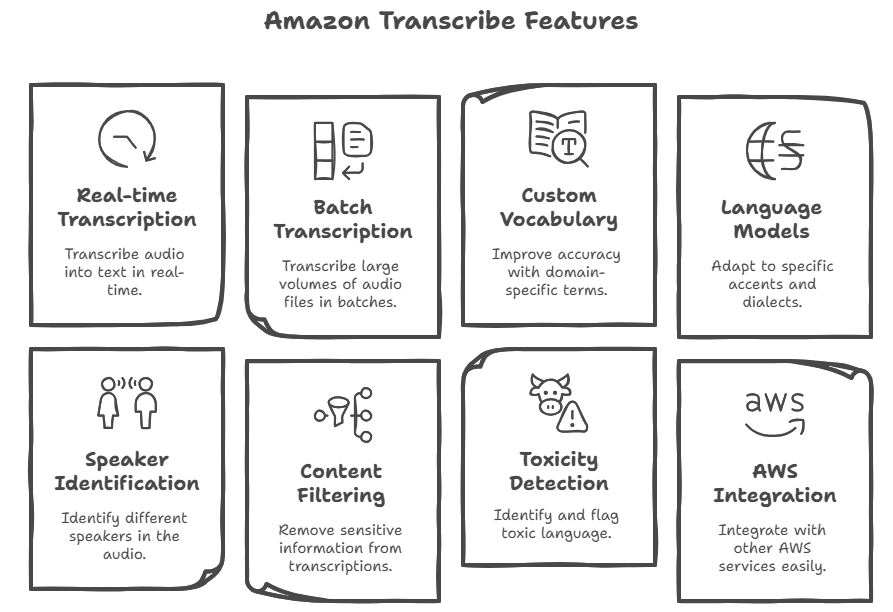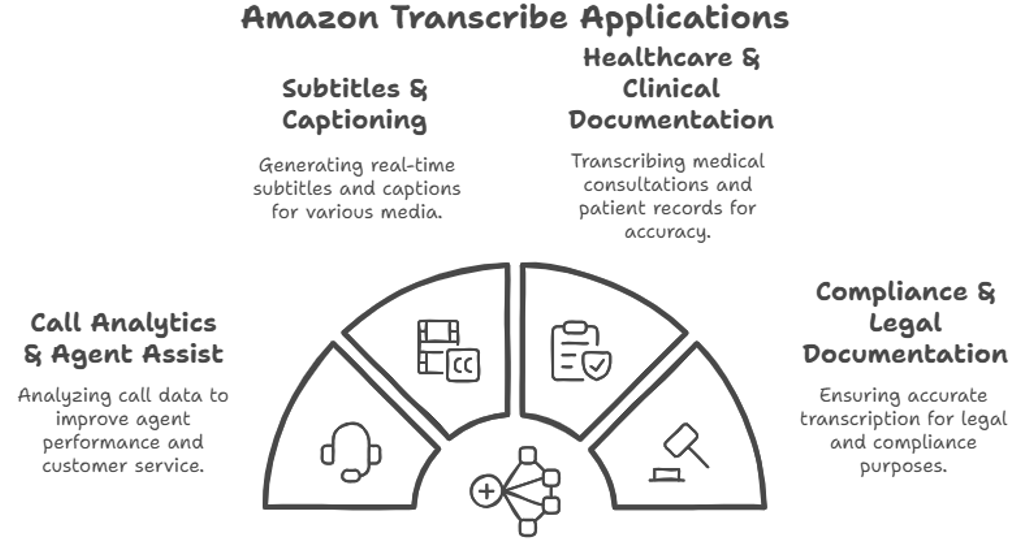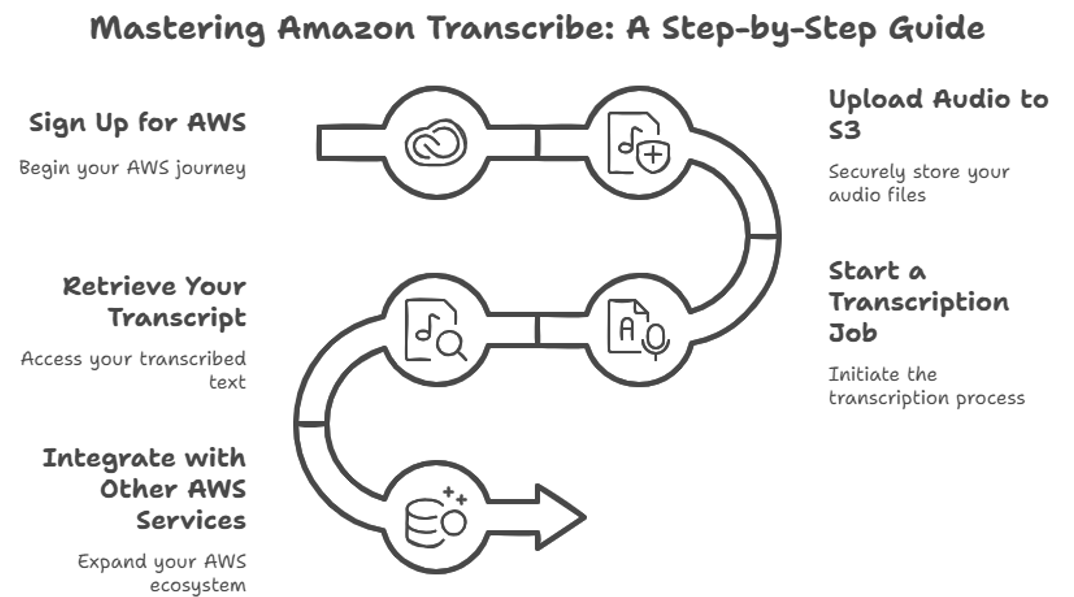Course
Imagine you have hours of customer service calls, meetings, or interviews that need to be transcribed. Manually typing them out would take almost forever. Amazon has a solution with Amazon Transcribe, which, as you will see in this article, is a very impressive AI-powered speech recognition service that transforms spoken words into text.
I will also talk about how it works, how Amazon Transcribe is powered by a multi-billion parameter speech foundation model / a highly advanced AI system trained on massive volumes of audio data. Thanks to this scale, Transcribe can understand a big range of speech patterns, regional accents, complex terminology, and dialects.
The Experience of Using Amazon Transcribe
Let me go more into how it works. Amazon Transcribe, as I said, uses advanced deep learning models to process audio data and generate accurate, time-stamped transcripts. Its working can be understood through its core components.
To begin with, you can provide both batches as well as streaming audio inputs for real-time transcription. So there is flexibility in terms of what use cases it can handle.

Amazon Transcribe Core Components. Source of Image: Napkin AI
You can select domain-specific models as Amazon Transcribe is suited can adapt to environments, like quiet studios or bustling call centers.
Amazon Transcribe can automatically detect which languages are being spoken in your audio files or live streams. There is no need to manually select a language first. It recognizes the main language being used, and can even catch when speakers switch between multiple languages, transcribing everything accurately.
This is perfect for:
- Customer calls where people might speak different languages
- Media libraries with content in various languages
- Checking if your videos/podcasts are properly labeled with the correct language.
Key features of Amazon Transcribe
There are several features available that make Amazon Transcribe a potent tool, some of which are discussed below.

Amazon Transcribe Features. Source of Image: Napkin AI
Different people have different transcription requirements. To accommodate this, Transcribe can handle audio files in batch as well as in real-time for live streaming. Alos, users can develop specialized vocabularies and language models to improve accuracy. This might be helpful when working with acronyms, industry-specific jargon, or unusual terminology.
Speaker identification is an additional feature that helps clearly distinguish multiple speakers in conversations. I think this would be a big help during meetings or interviews. More exactly, this is known as speaker diarization.
Transcribe also offers automatic content screening and redaction for companies handling sensitive data. This means PII data items such as names, addresses, and credit card numbers are masked to for compliance. The service may also identify and flag offensive content, such as threats and hate speech.
Last but not the least, Transcribe is able to connect with several other AWS services. This is as you would expect because AWS is known for this kind of thing. Compatibility with services such as Amazon S3 for storage, Amazon Comprehend for sentiment analysis, and AWS Lambda for automation.
Use cases for Amazon Transcribe
Amazon Transcribe is designed to be versatile so there are a lot of use cases. I will go into some of the main ones, but there’s no way to be fully comprehensive.

Use cases of Amazon Transcribe. Source of Image: Napkin AI
Call analytics & agent assist
With Amazon Transcribe Call Analytics, you can extract actionable insights from customer conversations. This analytics can be used further to monitor agent performance, create customized training programs, workforce optimization, and improve customer satisfaction.
Subtitles & captioning
You can automatically generate subtitles for your content that will enhance accessibility and engagement for your audience. Language customisation and content filtering can further help you to protect customer privacy or audience-appropriate language, and this will help increase effectiveness for your use case.
Healthcare & clinical documentation
With Amazon Transcribe Medical, healthcare professionals can easily transcribe patient conversations. This helps with record-keeping and compliance. The AI is even known to handle complex medical terminology, so that’s a great advantage as well.
Legal documentation
Legal analytics is a great use case of Amazon Transcribe. With live streaming of court proceedings now becoming a new normal, it is very much possible for legal firms to create accurate records of such legal proceedings - transcribing testimonies, rulings, and arguments.
I imagine this would have to reduce note-taking errors (very important in legal), speed up case reviews, and maybe even help spot key patterns in litigation trends using AI-powered search and analysis. All of this said, I should clarify that Transcribe is not certified for official legal recordkeeping in all jurisdictions.
Comparing Amazon Transcribe to Alternatives
Amazon Transcribe is packed with features, but depending on your specific needs and budget, it's always better to look at a few alternatives as well:
- Whisper (OpenAI) on EC2: A self-hosted ASR model that's often more cost-effective, especially when it involves heavy transcription workloads. Having said that, it also means taking on the extra work of managing your own infrastructure.
- Deepgram: A cloud-based option offering real-time transcription and competitive pricing, making it attractive for those seeking a fully managed solution.
- Azure Speech-to-Text & Google Speech-to-Text: These major players provide similar services, each with unique pricing models and integration options.
Some users have found success in reducing expenses by running Whisper locally or hosting ASR models themselves on AWS EC2. However, managing infrastructure comes with its own set of challenges, and that’s something to ponder upon.
Getting Started with Amazon Transcribe
The simple workflow to getting started with this service is described below.

Getting started with Amazon Transcribe. Source of Image: Napkin AI
Step 1: Sign Up for AWS
First things first: Create your AWS account. The good news is that you’ll get 60 minutes of free transcription every month for the first year.
Step 2: Upload Audio to S3
Next, upload your audio files into an Amazon S3 bucket. Think of S3 as your personal cloud storage space for all your files.
Step 3: Start a Transcription Job
Head over to Amazon Transcribe in the AWS Console. Choose between batch processing or real-time transcription. Don’t forget to select the language, turn on speaker identification if you need it, and add any custom vocabulary to boost accuracy.
Step 4: Retrieve Your Transcript
Once the job’s done, you can grab the output of your transcript in TXT, JSON, or SRT formats. Whatever works best for your project.
Step 5: Integrate with Other AWS Services
You can take this further by connecting with Amazon Comprehend for sentiment analysis or Amazon Translate if you want to create transcripts in another language.
Amazon Transcribe Pricing
Amazon Transcribe runs on a pay-as-you-go model, with charges based on the total audio length transcribed.
- Free tier: New AWS customers can transcribe up to 60 minutes per month for free during the first twelve months.
- Standard pricing: Beyond the free tier, costs are calculated based on audio duration, and rates vary depending on your region and how much you use. The Amazon Transcribe API for both streaming and batch transcriptions is billed monthly based on the tiered pricing, which can be explored here.
- Cost optimization tips: You can compress audio files to reduce transcription length and shorten transcription time. The cost would be reduced if you reduced the total audio duration, which is going to be the main billing factor. Additionaly, consider utilizing custom language models to improve accuracy, minimizing the need for manual corrections.
Pros and Cons of Amazon Transcribe
It's always a good idea to look at it based on your requirement, budget and the current technology stack.
|
Pros |
Cons |
|
High accuracy even in challenging audio environments. |
Costs can grow with large volumes |
|
Supports both real-time and batch transcription. |
Self-hosting alternatives need infrastructure management |
|
Custom vocabulary and language model support. |
Some features may come with extra fees. |
|
Smooth integration with other AWS services. |
Requires an AWS account and some familiarity with AWS. |
|
Handles multiple languages and dialects. |
Limited offline capabilities compared to local setups. |
Conclusion
If you're thinking about using Amazon Transcribe, it's important to evaluate your specific requirements carefully. If managing costs or infrastructure is a top priority, exploring alternatives like self-hosted ASR models could make sense. Making use of the AWS Free Tier and applying cost-saving strategies can help you get the most out of it.
If you are unfamiliar with Amazon products and services and the ecosystem as a whole, we have you covered:
- AWS Concepts: Discover the world of Amazon Web Services (AWS) and understand why it's at the forefront of cloud computing.
- AWS Cloud Technology & Services: Master AWS cloud technology with hands-on learning and practical applications in the AWS ecosystem.
- AWS Cloud Practitioner Certification (CLF-C02): Demonstrate your foundational knowledge of AWS cloud services and cloud computing.

Seasoned professional in data science, artificial intelligence, analytics, and data strategy.
FAQs
What is Amazon Transcribe?
Amazon Transcribe is an AI-powered service by AWS that converts spoken language into written text.
Does Amazon Transcribe work in real-time?
Yes, it supports both real-time transcription for live audio and batch processing for pre-recorded files.
How is Amazon Transcribe priced?
Pricing is based on how much audio you process, following a pay-as-you-go model. Plus, new users get 60 minutes free each month for the first year.
Is it possible to filter or redact sensitive information?
Yes, Amazon Transcribe can detect and automatically mask sensitive data like names, addresses, and credit card numbers.
How do I get started with Amazon Transcribe?
You need an AWS account, an S3 bucket for your audio files, and a configured transcription job through the AWS Console.
